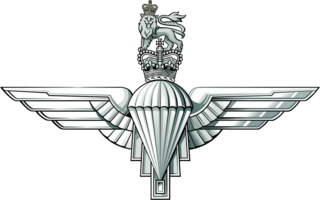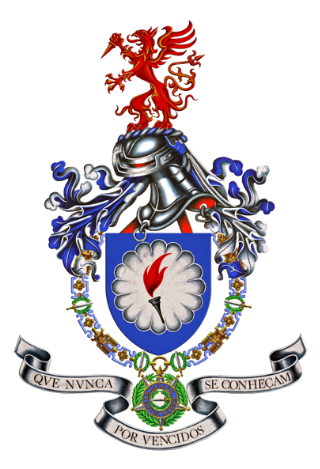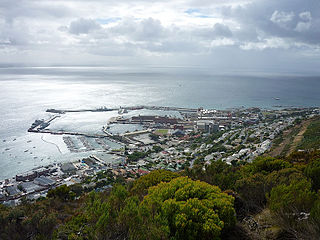
A paratrooper is a military parachutist—someone trained to parachute into a military operation, and usually functioning as part of an airborne force. Military parachutists (troops) and parachutes were first used on a large scale during World War II for troop distribution and transportation. Paratroopers are often used in surprise attacks, to seize strategic objectives such as airfields or bridges.

The Parachute Regiment, colloquially known as the Paras, is an airborne infantry regiment of the British Army. The first battalion is part of the Special Forces Support Group under the operational command of the Director Special Forces. The other battalions are the parachute infantry component of the British Army's rapid response formation, 16 Air Assault Brigade. The Paras, along with the Guards, are the only line infantry regiment of the British Army that has not been amalgamated with another unit since the end of the Second World War.

The South African Special Forces Brigade, colloquially known as the Recces, is South Africa's principal special operations unit, specialising in various types of operations, including counter-insurgency, long-range-reconnaissance, unconventional-warfare, special operations, hostage-rescue, and direct-action operations. The brigade operates with two active-duty groups, with 4 Special Forces Regiment focusing on maritime operations, and 5 Special Forces Regiment focusing on land and airborne operations. Only about 8% of recruits who undergo South African special forces training pass the course.

44 Parachute Regiment is the South African Army's chief airborne infantry unit. It was created in 2000 by redesignating 44 Parachute Brigade, and is based at the Tempe military base near Bloemfontein.
Jan Dirk Breytenbach is a retired career South African Special Forces military officer and author of military books. He is best known as the first commander of 1 Reconnaissance Commando, South Africa's first special-forces unit. In his long career, he served in the Suez Crisis, the Biafran War, the South African Border War, and the Angolan Civil War, and attained the rank of colonel before his retirement.

The South West Africa Territorial Force (SWATF) was an auxiliary arm of the South African Defence Force (SADF) and comprised the armed forces of South West Africa from 1977 to 1989. It emerged as a product of South Africa's political control of the territory which was granted to the former as a League of Nations mandate following World War I.

The 2nd Parachute Brigade was an airborne forces brigade formed by the British Army during the Second World War.

The Regimento de Paraquedistas, based in Tancos, Portugal, is a unit of the Portuguese Army and serves as the instruction center for recruitment and training of the Portuguese paratroopers. This unit includes an entire battalion, acting as support and reserve for airborne units which contains for example, military war dogs and airborne pathfinders and an instruction battalion responsible for the forming of new paratroopers.

South Africa currently does not have a marine corps, though in the past it did. It was originally set up as a sub-branch of the South African Navy during the apartheid era, with the primary purpose of protecting the country's harbours (1951-1955). Then it was recreated in 1979 during the South African Border War as 1-Marine Brigade with the aim of serving as marine infantry (1979-1990). Today, the SAN Maritime Reaction Squadron is the closest analogue to a marine corps South Africa has.

7 Medical Battalion Group is the specialist Airborne Medical Unit of the South African Military Health Service. The Battalion's main task is to render medical support to the South African Airborne and Special Forces.

44 Parachute Brigade was a parachute infantry brigade of the South African Army. It was founded on 20 April 1978, by Colonel Jan Breytenbach, following the disbandment of 1 SA Corps and the battle of Cassinga. Upon formation, the brigade was commanded by Brigadier M. J. du Plessis, who was assigned the task of establishing by working with the Parachute Staff Officer, Colonel Jan Breytenbach. At the time du Plessis was the commanding officer of the Orange Free State Command and had previous experience serving in 1 Parachute Battalion. Breytenbach had also been a member of 1 Parachute Battalion and had also founded the South African Special Forces Brigade and 32 Battalion. The location that was chosen for the brigade's headquarters was in the lines of the OFS Cmd Headquarters, next to the old Tempe Airfield in Bloemfontein.

The 11th Parachute Battalion was an airborne infantry battalion of the Parachute Regiment, raised by the British Army in World War II.

1 Parachute Battalion is the only full-time paratroop unit of the South African Army. It was founded on 1 April 1961, along with the Parachute Battalion. The name of this unit was changed to Parachute Training Centre after 1998. It was the first battalion within 44 Parachute Brigade until 1999 when the brigade was downsized to 44 Parachute Regiment

The Steve Biko Artillery Regiment is a airborne artillery regiment of the South African Artillery.

The 44 Pathfinder Platoon is part of the 44 Parachute Regiment. The pathfinder is a trained and specialized paratrooper, who performs covertly behind enemy lines, either in small groups or in collaboration with other reconnaissance units.

The Bagaka Regiment is a reserve airborne infantry regiment of the South African Army.
The Hunter Group was South Africa's first special forces unit and counter-insurgency elite formed in 1968, with members of the unit forming and training later special forces and other specialised units of the South African Army.

In April 1978, the South African Minister of Defence authorized the formation of 44 Signal Squadron. From 24 September 1980 until October 1986, 44 Signal Squadron supported 44 Brigade in all aspects of signals, e.g., the supply of communication and the manning of a Communication Centrum (Comcen). From 2 October 1986, the Squadron was upgraded to a Signal Unit with Commandant Lombard as commander and tasked to supply the Brigade with communication and establish a full-strength Unit. The unit's second in command was Maj P. Drotsky and the RSM P. Snyders. The signal unit flag was authorized in 1986. After the restructuring of the SADF as the SANDF in 1994, the unit was renamed 13 Signals Squadron.

911 Battalion was part of the South West African Territorial Force's 91 Brigade.
















